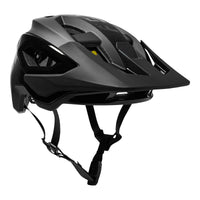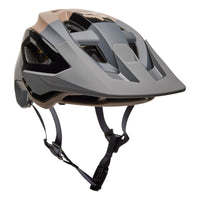Mountain biking has experienced many technological advancements over its relatively short lifetime. The competition between manufacturers to release the best products has benefited riders. Access to new technology has meant more refined and reliable products that enable us to ride harder and further than ever before. However, I believe the most impactful advancement isn’t the components found on a bike but the helmet we wear.
The early attempts at cycling helmets in the 1980s were little more than EPS foam bowls with a D-ring strap and vents scattered throughout. Safety standards were sparse, and the ones in place were laughable compared to today’s safety requirements. Hard plastic outer shells didn’t even become an industry norm until the '90s, and even then, helmets were known to suffer catastrophic failure after an impact. Comparatively, even the most entry-level modern helmet is significantly safer than a helmet from forty years ago.
I recently tried the latest safety technology by testing Fox’s Dropframe Pro and Speedframe Pro helmets. These two models are Fox’s most advanced open-face helmets. I spent the past few months evaluating their safety features and how they fit, feel, and perform out in the woods.
Is this trail…
The age-old debate for mountain bikers has been whether or not to wear a full-face helmet. If you’ve been riding long enough, chances are you’ve heard someone ask “is this trail full-face worthy?” What designates a trail as “full-face worthy” is highly subjective based on rider skill and comfort with taking on risk. Often, the factors at play when deciding between the two helmet styles are the balance between breathability and protection. While full-face helmets certainly provide the highest level of head protection, it comes at the cost of decreased airflow and increased weight. On a ride that includes many miles of undulating single-track, a traditional open-face style helmet will be more comfortable for the duration of the ride. That decision does come with the risk of leaving your face vulnerable and exposed in the event of a crash.

With lightweight full-face options like the Fox Proframe RS, choosing between wearing a full-face or half-shell is even more convoluted. For those who don't like the idea of pedaling with a chin bar, the Fox Dropframe Pro may be the most protective option available.
In recent years there’s been an increase in lightweight full-face helmets, such as the Proframe RS, to address some of the less desirable aspects of wearing a full-face. While lighter-weight helmets are a welcome alternative to a traditional full-face, there are still times a full-face may feel unnecessary. So what options are there when wanting the most protective open-face helmet possible? That’s where Fox’s Dropframe Pro comes into the picture. Featuring a design that offers more coverage on the sides and rear of the head while maintaining a lightweight construction, the Dropframe Pro is designed with the intention of being the most protective open-face helmet available.
Fox Dropframe Pro
Over time, mountain biking helmets have developed their own unique silhouette. Most prototypical trail helmets feature a highly ventilated shell, a visor, and a similar shape. By creating the Dropframe, Fox introduced a new profile for trail helmets in their lineup. Providing increased coverage while still maintaining the visibility and breathability of a traditional half-shell, the Dropframe aims to be the most protective half-shell helmet to date. One glance at its silhouette reveals a lot about the inspiration behind its appearance. The Dropframe shares a profile nearly identical to a conventional full face with its chin bar removed. It maintains the side and back coverage of a full-face while aiming to keep the airflow and openness of a traditional trail helmet. Theoretically, this design is the ideal compromise between a full-face and a conventional half-shell helmet.

Sharing a similar profile to a full-face sans chin bar, the Fox Dropframe offers ample protection to the sides and back of the head while maintaining the airflow and breathability of a standard trail helmet.
Virginia Tech Safety Rating
Nestled between the Allegany and the Blue Ridge Mountains, Virginia Polytechnic Institute and State University (Virginia Tech) have developed the gold standard for helmet testing. Since 2011, their researchers have been testing and providing results for helmets from numerous disciplines to inform consumers of their effectiveness with unbiased research. Every helmet tested receives a Summation of Test for the Analysis of Risk score (STAR). Results are represented by a STAR rating of one to five stars, indicating how likely an impact on the helmet will result in a concussion. Testing for helmets is done via a drop tower and a 45-degree angled anvil covered with 80-grit sandpaper to mimic asphalt. Forces represent realistic crash scenarios, targeting six specific points on the helmet. Based on this rating system, a one-star rated helmet would limit the chance of concussion by less than 40%, whereas a five-star rated helmet could limit the possibility of a concussion by 70% or more. Virginia Tech only recommends purchasing helmets with a four-star rating or higher. Upon its testing in 2020, the Dropframe Pro received a five-star rating and, at the time of testing, took the top spot as the safest open-face helmet.

Testing for helmets is done via a drop tower and a 45-degree angled anvil covered with 80-grit sandpaper to mimic asphalt. Forces represent realistic crash scenarios, targeting six specific points on the helmet.(Source: Virginia Tech, 2018:online)
Fit
The initial fit and feel of the Dropframe Pro are as unique as its silhouette. The increased coverage on the backs and sides of the helmet is immediately noticeable, as it fits more similarly to a full-face than a traditional open-face helmet. The profile securely cradles the back of the head, with the cheek pads applying sufficient pressure to keep the helmet firmly in place. Four sizes are available, ranging from small to extra large, accommodating a range of head sizes from 52 - 60mm in diameter. It’s important to note that, unlike most other helmets in Fox’s lineup, the Dropframe doesn’t have any ratcheting adjustment. Instead, it comes with a thicker padding set for those who are directly between sizes and need to tailor the fit. I typically wear a medium size helmet, and the medium Dropfram Pro was on the snug side with the thinnest pads installed, but it was still comfortable.

The increased coverage on the sides and back of the head create for a secure fit that remains comfortable for the duration of a ride.
Having over twenty years of baseball experience, I cannot help but compare the Dropframe Pro to a baseball helmet. After first trying the helmet on, I immediately said, “this feels exactly like a batting helmet.” Aside from having a somewhat similar visual profile, the way the ear panels sit securely on the sides of the head is nearly identical in feel. This is not a backhanded compliment, as a quality baseball helmet comfortably stays in place running the bases or sliding headfirst without a chin strap. They are also robust enough to protect against a 90 mph fastball to the head, which I have personally been the unlucky recipient of on more than one occasion. Certainly a bit of a niche comparison for the average mountain biker, but the similarities are too apparent to go unmentioned.

Having over fifteen years more experience playing baseball than I do mountain biking, my opinion that the Dropframe Pro fits precisely like a batting helmet is well-founded. (Source: Averett University Athletics, 2018:online)
Riding Impressions
I spent most of my time testing the Dropeframe Pro on various trail rides around the Bellingham area. The aspect of the Dropframe that stood out to me on the trail was its lightweight feel. Weighing 485g for a size medium, the Dropframe goes unnoticed, perhaps even more so than a traditional helmet. This is because the helmet wraps around the head’s sides and back, distributing its weight more evenly. Comparing this helmet to a traditional half-shell, the Dropframe securely cradles the entirety of your head instead of being perched on top.
The Dropframe has 15 vents and moisture-wicking liners for heat management and increased airflow. Running hot was never a threat during my testing, as it mainly took place over the fall and winter. Even so, I didn’t notice increased sweating in the Dropframe compared to a standard trail helmet. While its large visor is not adjustable, it’s fixed in a neutral position that didn’t distract me while riding. Replacement visors are available through Fox if needed.

The combination of thorough ventilation and a high-coverage shell make the Fox Dropframe Pro one of the most comprehensive trail helmets on the market.
The helmet remained very securely seated even in the roughest root-ridden terrain. Unlike some MIPS-equipped helmets plagued by a distracting squeaking sound, its MIPS liner remained silent. I fortunately never had any considerable crashes to test this helmet’s protective nature. Still, the increased coverage provided a greater sense of protection than other open-face helmets I’ve used.
Speedframe Pro
Taking a more traditional approach to helmet design, the Speedframe Pro shares a similar profile to many other open-face helmets on the market. A size medium weighs 105g less than its Dropframe Pro counterpart, although it offers less coverage on the sides and back of the head.

The Speedframe Pro is Fox's flagship half-shell helmet, incorporating the latest safety-tech while maintaining a traditional half-shell profile.
Fit / Safety
The Speedframe Pro is available in sizes SM, MD, and LG. Unlike the Dropframe, the Speedframe Pro has a 360-degree Fit System dial to allow a wide range of adjustments with a specific size. The helmet’s 19 vents make it one of the most breathable helmets I’ve tested. I could distinctly feel air channeling through the three centermost vents on the helmet’s brow when descending at speed. The Speedframe Pro comes equipped with MIPS technology for rotational impact absorption and a FidLock release strap. While offering less coverage than the Dropframe, the Speedframe still received a 5-star rating from Virginia Tech, making it one of the safest traditional half-shells on the market.

The Speedframe Pro received a 5-star rating from Virginia Tech, making it one of the safest traditional half-shells on the market.
Riding Impressions
There is little to complain about with the Speedframe Pro in real-world riding applications. More minor details, such as its adjustable straps and ratcheting adjustment dial, make fine-tuning the fit simple enough that it can be done quickly in the parking lot or at the top of a trailhead. The helmet has an indentation along its sides, making it goggle-compatible. I also tested the Speedframe Pro with various riding glasses without issue. It was nice to have the option of an adjustable visor, although it doesn’t actuate quite as fluidly as some others I’ve used. However, once locked in place, it remained secure. While it’s not necessarily a flashy piece of kit, this is a helmet I’d be confident in for any trail ride.

Logan putting his Fox Speedframe Pro through the paces aboard a Transition Smuggler.
Verdict
It didn’t take long to realize these helmets aren’t just generic dual-foam lids but are legitimate attempts at furthering head protection in mountain biking. The Fox Dropframe and Speedframe exemplify how far cycling safety standards have come in the past years. User-friendly features and pleasing aesthetics aside, these helmets are scientifically proven to be among the safest options today. Both helmets passed Virginia Tech’s scrutiny with top honors of a 5-star safety rating, making them undeniable front runners in the trail helmet category.
Related Products
More Articles You Might Like
Stumpjumper 15 Vivid Air Review // Stumpjumper 15 Compared to Stumpjumper EVO
Product Reviews / BK Stancil / Nov 15, 2024
I’d summarize the ride quality of the Stumpjumper as Read More
SRAM Eagle GX/X01 Review // The Best Budget Cable Actuated Drivetrain
Product Reviews / BK Stancil / Nov 06, 2024
A combination of Sram Eagle GX and X01 components remain...
Read MoreThe Bikes We Ride // Rocky Mountain Altitude Bike Check
Bike Checks / BK Stancil / Nov 01, 2024
Rocky Mountain’s all-new Altitude immediately caught Shayne’s eye upon release with ...
Read MoreView More:




